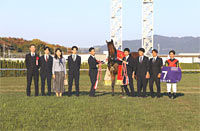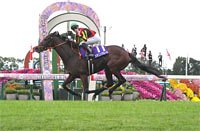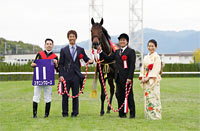Queen Elizabeth II Cup (G1) - Data Analysis
Race to decide the autumn champion filly
The Queen Elizabeth II Cup is the pinnacle of autumn racing for fillies and mares aged 3 and up. In this clash between previous race winners and others aiming for their first title, runners backed as 6th favorite or lower have finished in the Top 2 in five of the last 10 years. Last year’s winner Queens Ring maintained good form after winning the Fuchu Himba Stakes, but the runner-up was the 12th favorite Sing with Joy. This year, then, we should again be wary of dark horses. But first, let’s look at some trends in this race from data over the last 10 years.
Check the performance by age
If we aggregate performances by runners over the last 10 years in terms of their age, we find that 3-year-olds have the highest Top 2 ratio, followed by 4-year-olds, while horses aged 5 and up have tended to struggle. Actually, two 5-year-olds have won this race – Queen Spumante in 2009 (11th favorite) and Rainbow Dahlia in 2012 (7th favorite) – and both were Kanto (Miho)-trained horses. [Table 1]
[Table 1] Performance by distance of the previous race (last 10 years)
| Age |
Performance
[1st-2nd-3rd-4th or lower] |
Win ratio |
Top 2 ratio |
Top 3 ratio |
| 3 |
4-4-3-36 |
8.5% |
17.0% |
23.4% |
| 4 |
4-3-6-42 |
7.3% |
12.7% |
23.6% |
| 5 |
2-2-0-43 |
4.3% |
8.5% |
8.5% |
| 6 |
0-1-1-12 |
0% |
7.1% |
14.3% |
| 7 and up |
0-0-0-6 |
0% |
0% |
0% |
Also check performance by “favoritism”
In terms of the performance by favoritism over the last 10 years, the 1st favorites have the best record with a Top 3 ratio of 80.0%. The two 1st favorites beaten to 4th or lower had both most recently contested a Grade 2 race, in which they were backed among the top three favorites but finished 5th or lower. Of the 10 runners finishing 1st, 2nd and 3rd, respectively, seven of the 10 in each placing had been backed among the top four favorites. Turning next to the performance by win odds, the fact that runners backed by odds of “2.9 or lower” have achieved a Top 3 ratio of 100% should be worthy of attention. So, although dark horses are by no means rare, it would seem that the more highly favored horses are basically in the ascendancy. [Table 2] [Table 3]
[Table 2] Performance by favoritism (last 10 years)
| Favoritism |
Performance
[1st-2nd-3rd-4th or lower] |
Win ratio |
Top 2 ratio |
Top 3 ratio |
| 1st favorite |
2-4-2-2 |
20.0% |
60.0% |
80.0% |
| 2nd favorite |
1-2-3-4 |
10.0% |
30.0% |
60.0% |
| 3rd favorite |
2-1-0-7 |
20.0% |
30.0% |
30.0% |
| 4th favorite |
2-0-2-6 |
20.0% |
20.0% |
40.0% |
| 5th favorite |
0-0-2-8 |
0% |
0% |
20.0% |
| 6th, 7th favorite |
2-1-1-16 |
10.0% |
15.0% |
20.0% |
| 8th-10th favorite |
0-0-0-30 |
0% |
0% |
0% |
| 11th, 12th favorite |
1-2-0-17 |
5.0% |
15.0% |
15.0% |
| 13th favorite or lower |
0-0-0-49 |
0% |
0% |
0% |
[Table 3] Performance by win odds (last 10 years)
| Win odds |
Performance
[1st-2nd-3rd-4th or lower] |
Win ratio |
Top 2 ratio |
Top 3 ratio |
| 2.9 or lower |
2-2-2-0 |
33.3% |
66.7% |
100.0% |
| 3.0-4.9 |
1-4-1-3 |
11.1% |
55.6% |
66.7% |
| 5.0-9.9 |
3-1-3-13 |
15.0% |
20.0% |
35.0% |
| 10.0-19.9 |
2-1-4-21 |
7.1% |
10.7% |
25.0% |
| 20.0-29.9 |
1-0-0-19 |
5.0% |
5.0% |
5.0% |
| 30.0-49.9 |
0-0-0-21 |
0% |
0% |
0% |
| 50.0-99.9 |
1-2-0-31 |
2.9% |
8.8% |
8.8% |
| 100 or higher |
0-0-0-31 |
0% |
0% |
0% |
Pointers also seen in the performance by horse number
Looking into performances by horse number over the last 10 years, an unusual characteristic is that six of the 10 winners had been numbered “1-8,” eight of the 10 runners-up had been “9-18,” and seven of the 10 3rd-placed finishers had been “1-8.” These could be taken as useful statistics when planning bet formations. [Table 4]
[Table 4] Performance by horse number (last 10 years)
| Horse number |
Performance
[1st-2nd-3rd-4th or lower] |
Win ratio |
Top 2 ratio |
Top 3 ratio |
| 1, 2 |
1-1-1-17 |
5.0% |
10.0% |
15.0% |
| 3, 4 |
2-0-2-15 |
10.5% |
10.5% |
21.1% |
| 5, 6 |
1-1-2-16 |
5.0% |
10.0% |
20.0% |
| 7, 8 |
2-0-2-16 |
10.0% |
10.0% |
20.0% |
| 9, 10 |
0-2-0-18 |
0% |
10.0% |
10.0% |
| 11, 12 |
1-3-0-15 |
5.3% |
21.1% |
21.1% |
| 13, 14 |
0-0-1-19 |
0% |
0% |
5.0% |
| 15, 16 |
2-1-2-12 |
11.8% |
17.6% |
29.4% |
| 17, 18 |
1-2-0-11 |
7.1% |
21.4% |
21.4% |
Another trend in the performance by previous race
On aggregating performances by runners over the last 10 years in terms of their previous race, we find that the “Shuka Sho” has produced the most winners here (three). A runner most recently contesting an “Overseas G1 race” has won twice, but on both occasions it was the UK-trained Snow Fairy. As for the others, fillies coming straight from the “Fuchu Himba Stakes” have finished 1st and 2nd twice each, but their overall Top 3 ratio is only 12.3%. So, although the latter is positioned as the main prep race for the Queen Elizabeth II Cup, it seems to be no guarantee of success. By contrast, runners coming from “Other domestic G2 races” have posted better performances. In specific, five horses previously seen in the Sankei Sho All Comers have performed particularly well, with two wins and one runner-up spot. [Table 5]
[Table 5] Performance by previous race (last 10 years)
| Previous race |
Performance
[1st-2nd-3rd-4th or lower] |
Win ratio |
Top 2 ratio |
Top 3 ratio |
| Shuka Sho |
3-3-3-25 |
8.8% |
17.6% |
26.5% |
| Domestic G1 in spring |
0-0-1-3 |
0% |
0% |
25.0% |
| Overseas G1 |
2-0-0-3 |
40.0% |
40.0% |
40.0% |
| Fuchu Himba Stakes |
2-2-4-57 |
3.1% |
6.2% |
12.3% |
| Other domestic G2 |
3-3-1-11 |
16.7% |
33.3% |
38.9% |
| Other domestic G3 |
0-1-0-6 |
0% |
14.3% |
14.3% |
| Overseas G2, G3 |
0-0-0-3 |
0% |
0% |
0% |
| Other races |
0-1-1-31 |
0% |
3.0% |
6.1% |
Look out for fillies with a poor G1 record in the same year
In the Queen Elizabeth II Cup over the last 10 years, one horse with experience of being beaten to “6th or lower in a G1 race in the same year” has finished in the Top 2 every year except 2011. It would be a good idea to check whether any runner with this kind of experience is contesting in this year’s race as well. [Table 6]
[Table 6] Top 2 finishers in the Queen Elizabeth II Cup G1 beaten to 6th or lower in a G1 race in the same year (last 10 years)
| Finish |
Performance
[1st-2nd-3rd-4th or lower] |
Win ratio |
Top 2 ratio |
Top 3 ratio |
| 2007 |
2nd |
Fusaichi Pandora |
Victoria Mile |
12th |
| 2008 |
1st |
Little Amapola |
Shuka Sho |
6th |
| 2009 |
2nd |
T M Precure |
Tenno Sho (Spring) |
18th |
| 2010 |
2nd |
Meisho Beluga |
Takarazuka Kinen |
6th |
| 2012 |
1st |
Rainbow Dahlia |
Victoria Mile |
12th |
| 2013 |
1st |
Meisho Mambo |
Oka Sho |
10th |
| 2014 |
1st |
Lachesis |
Victoria Mile |
15th |
| 2015 |
2nd |
Nuovo Record |
Victoria Mile |
6th |
| 2016 |
1st |
Queens Ring |
Victoria Mile |
8th |
Note: When there is more than one race in question, the most recent one is shown.
Seek out the winner!
Four straight wins by horses ridden by the same jockey for at least the last four races
The last four winners of the Queen Elizabeth II Cup had been “ridden by the same jockey for at least the previous four races.” Of all graded races limited to fillies and mares, this is the second longest behind the Yushun Himba (Japanese Oaks). That may be why so much success is going to horses ridden by the same jockeys, giving them a better understanding of their horses’ characteristics which is crucial in a long-distance race. [Table 7]
[Table 4] Winning horses’ highest finish in a graded race in the previous four outings (last 9 years)
| Year |
Winning horse |
Highest finish |
| 2013 |
Meisho Mambo |
Koshiro Take |
From 4 races back |
| 2014 |
Lachesis |
Yuga Kawada |
From 7 races back |
| 2015 |
Marialite |
Masayoshi Ebina |
From 5 races back |
| 2016 |
Queens Ring |
Mirco Demuro |
From 4 races back |
(Yasunori Asano) |



















